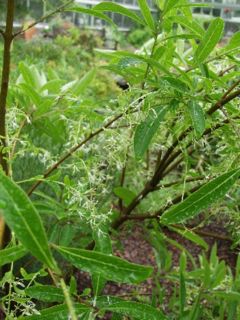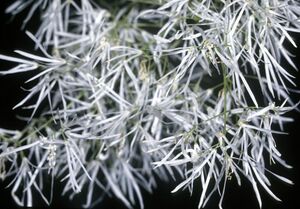Chionanthus
| Standard Cyclopedia of Horticulture |
|---|
|
Chionanthus (Greek for snow and flower; alluding to the abundance of snow-white fls.). Oleaceae. Fringe Tree. Woody plants grown for their profusely produced white flowers. Shrubs or low trees, with deciduous, opposite and entire lvs.: fls. in loose panicles from lateral buds at the end of last year's branches, white, dioecious or only functionally dioecious; calyx 4-cleft; corolla divided nearly to the base in 4 narrow petals; stamens 2, short; ovary superior, 2-celled; style very short with a 2- lobed stigma: fr. a 1-seeded oval drupe.—Two species in E. N. Amer. and China. Ornamental shrubs, with large, dark green foliage, and very showy white fls. in early summer. The American species is almost hardy N., but requires a somewhat sheltered position; the Chinese may be more tender, but has proved hardy at the Arnold Arboretum. They thrive best in a somewhat moist and sandy loam, and in a sunny position. Prop. by seeds sown in fall or stratified; increased also by layers and by grafting under glass or budding in the open air on ash seedlings (in Europe, Fraxinus Ornus is preferred); sometimes by cuttings from forced plants in early spring.
The above text is from the Standard Cyclopedia of Horticulture. It may be out of date, but still contains valuable and interesting information which can be incorporated into the remainder of the article. Click on "Collapse" in the header to hide this text. |
| Chionanthus {{{status}}} Fossil range: {{{fossil_range}}}
| ||||||||||||||||||||||||||||||||||||||||||||||||||||||||||||||||||
|---|---|---|---|---|---|---|---|---|---|---|---|---|---|---|---|---|---|---|---|---|---|---|---|---|---|---|---|---|---|---|---|---|---|---|---|---|---|---|---|---|---|---|---|---|---|---|---|---|---|---|---|---|---|---|---|---|---|---|---|---|---|---|---|---|---|---|
 Chionanthus pygmaeus | ||||||||||||||||||||||||||||||||||||||||||||||||||||||||||||||||||
| Plant Info | ||||||||||||||||||||||||||||||||||||||||||||||||||||||||||||||||||
| ||||||||||||||||||||||||||||||||||||||||||||||||||||||||||||||||||
| Scientific classification | ||||||||||||||||||||||||||||||||||||||||||||||||||||||||||||||||||
| ||||||||||||||||||||||||||||||||||||||||||||||||||||||||||||||||||
| [[{{{diversity_link}}}|Diversity]] | ||||||||||||||||||||||||||||||||||||||||||||||||||||||||||||||||||
| {{{diversity}}} | ||||||||||||||||||||||||||||||||||||||||||||||||||||||||||||||||||
| Binomial name | ||||||||||||||||||||||||||||||||||||||||||||||||||||||||||||||||||
| {{{binomial}}} | ||||||||||||||||||||||||||||||||||||||||||||||||||||||||||||||||||
| Trinomial name | ||||||||||||||||||||||||||||||||||||||||||||||||||||||||||||||||||
| {{{trinomial}}} | ||||||||||||||||||||||||||||||||||||||||||||||||||||||||||||||||||
| Type Species | ||||||||||||||||||||||||||||||||||||||||||||||||||||||||||||||||||
| {{{type_species}}} | ||||||||||||||||||||||||||||||||||||||||||||||||||||||||||||||||||
| Species | ||||||||||||||||||||||||||||||||||||||||||||||||||||||||||||||||||
| See text | ||||||||||||||||||||||||||||||||||||||||||||||||||||||||||||||||||
| [[Image:{{{range_map}}}|{{{range_map_width}}}|]] | ||||||||||||||||||||||||||||||||||||||||||||||||||||||||||||||||||
| Synonyms | ||||||||||||||||||||||||||||||||||||||||||||||||||||||||||||||||||
| {{{synonyms}}} |
Chionanthus (syn. Linociera Sw.) is a genus of about 80 species of flowering plants in the family Oleaceae.

The genus has a wide distribution primarily in the tropics and subtropics, but with two species extending north into temperate regions, one (C. retusus) in eastern Asia and one (C. virginicus) in eastern North America. Most of the tropical species are evergreen, while the two temperate species are deciduous; some botanists restrict Chionanthus to the two deciduous, temperate species, treating the evergreen species in a separate genus Linociera, but apart from leaf persistence, there is no other consistent difference between them (Flora of China).
They are shrubs and small to medium-sized trees growing to 3-25 m tall. The leaves are opposite, simple. The flowers are produced in feathery panicles, with a corolla subdivided into four slender lobes; they are white, pale yellow, or tinged pink. The fruit is a drupe containing a single seed.
- Selected species
- Chionanthus axillaris R.Br. Australia (Queensland).
- Chionanthus axilliflorus (Griseb.) Stearn. Caribbean.
- Chionanthus brachythyrsus (Merrill) P.S.Green. Southern China (Hainan), Vietnam.
- Chionanthus caudatus (Collett & Hemsley) Bahadur & Gaur. Myanmar.
- Chionanthus compactus Sw. Caribbean.
- Chionanthus domingensis Lam. Caribbean.
- Chionanthus foveolatus (E.Mey.) Stearn (Pock Ironwood). Southern Africa.
- Chionanthus guangxiensis B.M.Miao. Southeastern China (Guangxi).
- Chionanthus hainanensis (Merrill & Chun) B.M.Miao. Southern China (Hainan).
- Chionanthus henryanus P.S.Green. Southwestern China, Myanmar.
- Chionanthus holdridgei (Camp & Monachino) Stearn. Caribbean.
- Chionanthus intermedius (Wight) F.Muell. India.
- Chionanthus ligustrinus (Sw.) Pers. Caribbean.
- Chionanthus longiflorus (H.L.Li) B.M.Miao. Southwestern China (Yunnan).
- Chionanthus picrophloia F.Muell. Australia (Queensland).
- Chionanthus pubescens Kunth. Ecuador, Peru.
- Chionanthus pygmaeus Small (Pygmy Fringetree). Southeastern United States (Florida).
- Chionanthus quadristamineus F.Muell. Australia (Norfolk Island).
- Chionanthus ramiflorus Roxburgh. Australia (Queensland), southern China, India, Nepal, Vietnam.
- Chionanthus retusus Lindley & Paxton (Chinese Fringetree). China, Japan, Korea.
- Chionanthus sleumeri (C.T.White) Stearn. Australia (Queensland).
- Chionanthus virginicus L. (White Fringetree). Eastern United States.